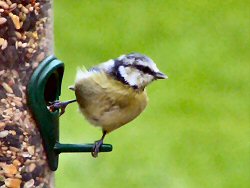More good news of the garden's breeding birds and another insect 'event'.
 Blue tit on feeder.
Blue tit on feeder.
Further to my diary entry for
May 16th, I can confirm that the blue tits (
Parus caerulea) in the box on the birch tree (
Betula sp.) are very busily feeding young - I must have misread signs of their demise back in May! An added bonus is another family of blue tits busily feeding young in a nestbox on the front of the house. The starlings (
Sturnus vulgaris) now appear to be incubating in the nestbox which I put on the house this year. At last I've seen house martins (
Delichon urbica) in our street - indeed they briefly explored the artificial nest on my house. Sadly the visit was all too brief and after their initial 10 minute exploration, I have not seen them again. House martins seem to be generally scarce in my town this year.
I make no secret of the fact that I am a wasp lover! (See for example the feature on
wasps). Since becoming very fond of these insects, I have longed to find a nest - preferably one in my garden. So it was with mixed feelings that, whilst digging up some loam from an old pile of inverted turves, I felt the sharp pain of a wasp sting on my forearm and realised that I had disturbed a wasp nest.
 The impossibly cute red wasp!
The impossibly cute red wasp!
In truth the pain was very mild - just like a pin prick really (it was nothing compared to the irritation of the itching which arrived the next day). I was saddened to see that rather than just disturb the wasps I had actually dug out an entire nest of the distinctively marked red wasp (
Vespula rufa). This was a very early nest - no bigger than a tea bag and very similar looking (the paper it was made from had a very lacy, indeed tea-bag-like, quality). There was something like 15-20 large grubs in the nest. I picked it up and put it back into the mound of earth from which I had dug it. Soon worker wasps, now oblivious to my presence, were attempting to repair the nest. I could see about half a dozen workers and the larger queen (she had much less of the red colouration on her abdomen). I covered the exposed nest with some roofing tiles. From time to time during the rest of the day I removed the tiles to examine the nest. Calm seemed to be restored - the wasps tending the grubs.
I had high hopes of being in the privileged position of watching this nest develop over the coming weeks. Sadly the next day I examined the nest only to find a scene of devastation. There were dead and dying workers (some with their wings removed) and dead grubs. All around were what I assumed to be the culprits - small black ants (probably
Lasius niger). Clearly exposing the nest, whilst not directly destroying it, had signalled its demise. I can only hope that the next time I encounter a nest, I notice it before putting a spade through it.